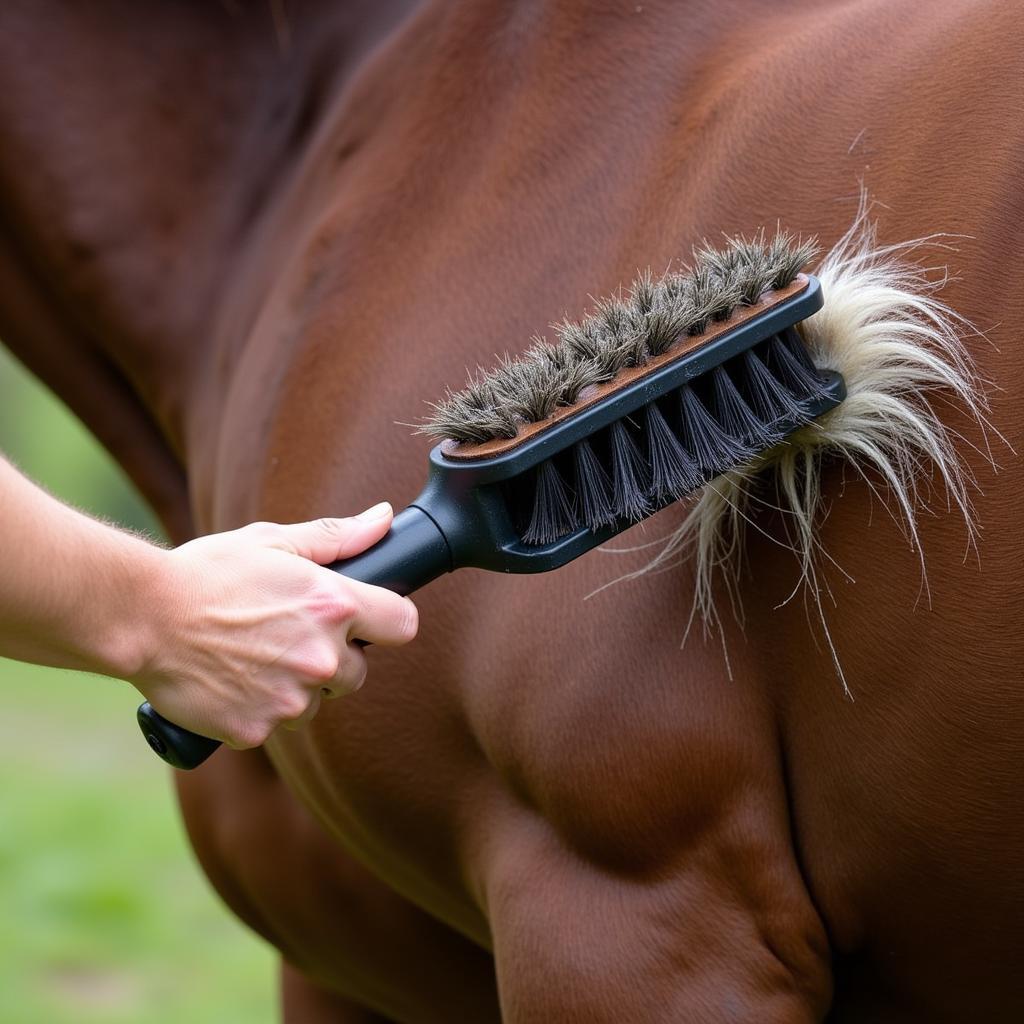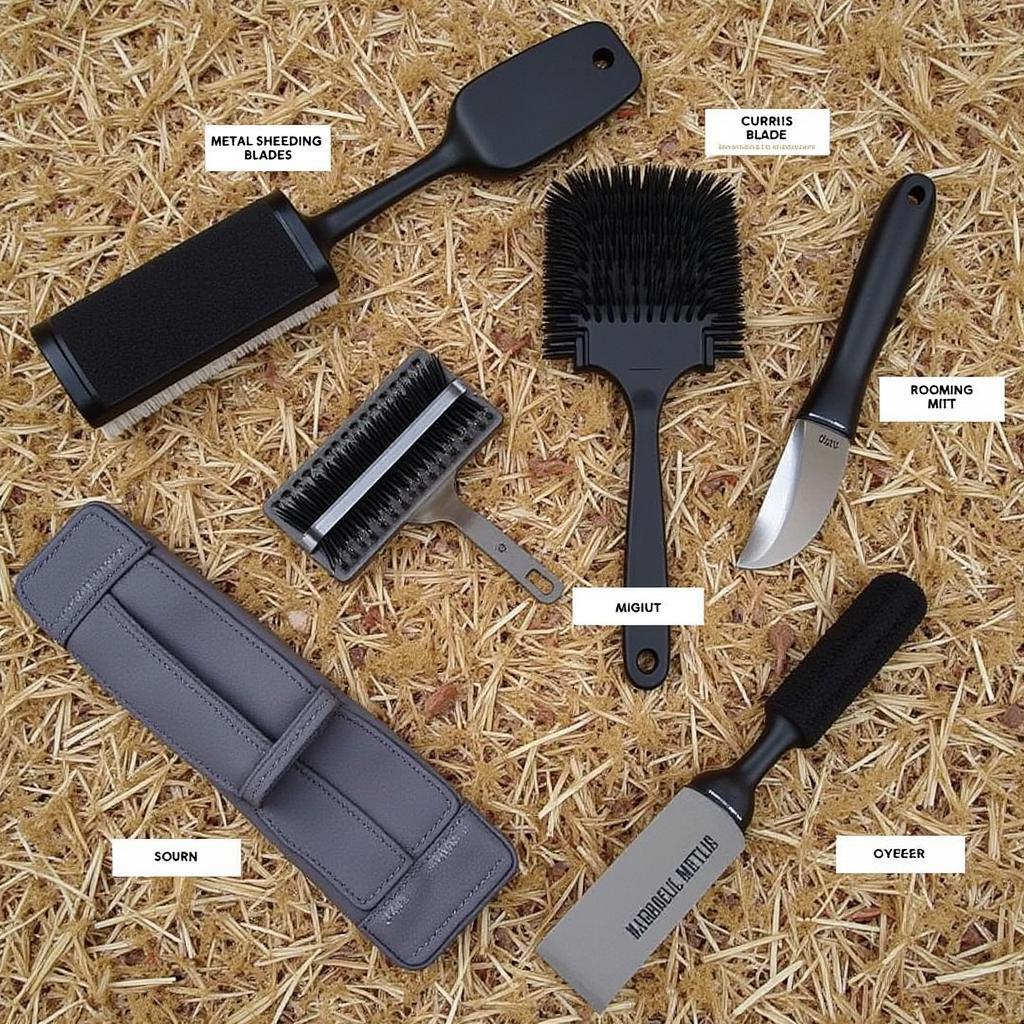Horse moulting season can be a challenging time for both horse and owner. A good Horse Moulting Brush is essential for managing the shedding process, keeping your horse comfortable, and maintaining a healthy, shiny coat. Choosing the right brush can make all the difference, and this guide will help you navigate the world of horse moulting brushes, ensuring you’re equipped to tackle even the heaviest shedding season.
Understanding the Importance of a Horse Moulting Brush
Why is a specialized brush so important for moulting? A regular grooming brush simply isn’t designed to handle the sheer volume of hair a horse sheds during moulting season. Moulting brushes are specifically engineered with features like curved blades or closely spaced teeth that effectively remove loose hair without damaging the horse’s skin or coat. They also stimulate circulation and distribute natural oils, promoting healthy skin and a glossy coat. Using the right brush will also significantly reduce the time and effort required for grooming during this period.
 Horse moulting brush removing loose hair effectively
Horse moulting brush removing loose hair effectively
Choosing the Right Horse Moulting Brush: A Comprehensive Guide
There are various types of moulting brushes available, each with its own advantages. Understanding the different types will help you select the perfect brush for your horse’s individual needs. Some popular options include shedding blades, curry combs, and rubber grooming mitts. Shedding blades are incredibly efficient at removing loose hair, while curry combs are great for loosening dirt and debris. Rubber grooming mitts are a versatile choice, suitable for both shedding and general grooming.
Types of Horse Moulting Brushes
- Shedding Blades: These metal blades with serrated edges are highly effective in removing loose hair, particularly during heavy shedding periods. They should be used with caution and a light touch to avoid skin irritation.
- Curry Combs: Often made of rubber or plastic, curry combs help loosen dirt, dander, and loose hair, preparing the coat for further brushing. They are also beneficial for massaging the horse and stimulating circulation.
- Rubber Grooming Mitts: These versatile mitts are ideal for removing loose hair, massaging the horse, and even applying shampoo. The rubber texture provides a comfortable grip and is gentle on the horse’s skin.
 Various horse moulting brushes including shedding blades, curry combs, and rubber grooming mitts
Various horse moulting brushes including shedding blades, curry combs, and rubber grooming mitts
How to Use a Horse Moulting Brush Effectively
Using a horse moulting brush correctly is crucial for maximizing its effectiveness and ensuring your horse’s comfort. Always start with a curry comb to loosen dirt and debris. Then, use the moulting brush in short, gentle strokes in the direction of hair growth. Avoid applying too much pressure, as this can irritate the horse’s skin. Regularly clean your moulting brush to remove trapped hair and maintain its effectiveness.
Tips for a Comfortable Grooming Experience
- Start Slowly: Introduce the moulting brush gradually, allowing your horse to become accustomed to the sensation.
- Use Positive Reinforcement: Reward your horse with treats or praise for good behavior during grooming.
- Be Mindful of Sensitive Areas: Avoid using the moulting brush on bony prominences or sensitive areas.
Maintaining Your Horse Moulting Brush
Keeping your moulting brush clean is essential for its longevity and effectiveness. After each use, remove any trapped hair and debris. Wash the brush with mild soap and water as needed, and allow it to dry completely before storing. Proper care will ensure your moulting brush remains a valuable grooming tool for years to come.
Conclusion
Choosing the right horse moulting brush is a crucial aspect of horse care, especially during shedding season. By understanding the different types of brushes available and using them correctly, you can effectively manage your horse’s shedding, promoting a healthy, shiny coat and a comfortable grooming experience. A quality horse moulting brush is an investment in your horse’s well-being.
FAQs
- How often should I use a moulting brush on my horse?
- Can I use a moulting brush on a horse with sensitive skin?
- What are the signs of a dull shedding blade?
- How do I clean a rubber grooming mitt?
- What is the best type of moulting brush for a horse with a thick coat?
- How can I tell if my horse is allergic to a moulting brush?
- When does moulting season typically occur?
For further assistance, please contact us at Phone: 0772127271, Email: [email protected] or visit us at QGM2+WX2, Vị Trung, Vị Thuỷ, Hậu Giang, Vietnam. We have a 24/7 customer service team.